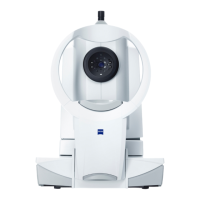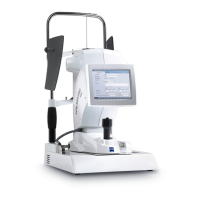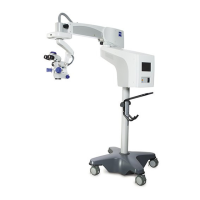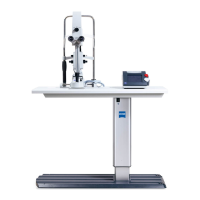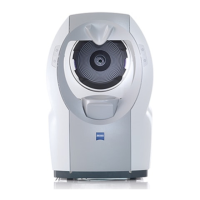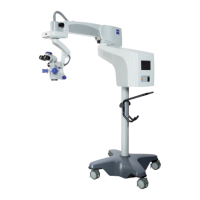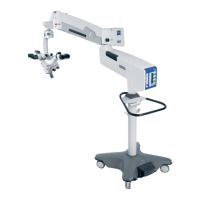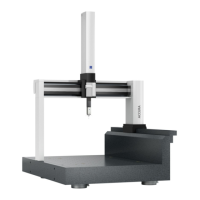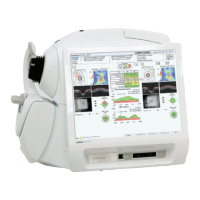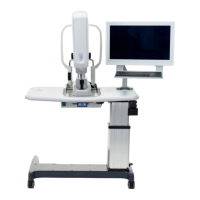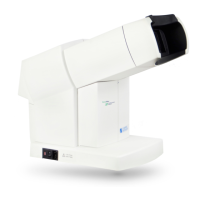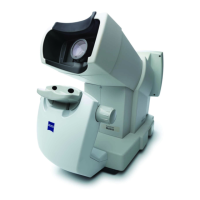Do you have a question about the Zeiss IOLMaster and is the answer not in the manual?
General safety principles, pictograms, and regulatory compliance.
Guidelines for safe installation, usage, intended use, and disposal of the instrument.
Safety measures for electrical hazards and light emission from the instrument.
Operational requirements and proper instrument use guidelines.
Identification of instrument controls and a list of optional accessories.
Procedure for unpacking, removing locks, and connecting the instrument.
Description of the IOLMaster's capabilities in measuring eye parameters for IOL calculation.
Operating the software via Windows interface, touchpad, keyboard, or mouse.
Screen elements, buttons, shortcut keys, and their functions for operation.
Explanation of displayed values, SNR categories, and their implications in ALM.
Overview of the main menu structure including Patient, Functions, AL Settings, and Options.
Procedure for creating surgeon profiles and managing password protection for databases.
Procedures for backing up, restoring, and importing IOL data.
Configuration of Date/Time, Program Settings, Regional, and Keyboard options.
Management of printers, software options, and updates.
Procedure for powering on the instrument and entering patient data.
Procedures for aligning the instrument to the patient's eye for measurements.
Activating ALM mode and using ALSettings for measurement.
Steps for performing axial length measurements, including patient fixation and signal interpretation.
Activating KER mode, aligning the instrument, and focusing for measurement.
Procedure for taking KER measurements and understanding the displayed results.
Options for multiple keratometer measurements, deleting results, and evaluating differences.
Activating ACD mode, aligning the instrument, and performing the measurement.
Activating WTW mode, aligning the instrument, and performing the measurement.
Procedure for measuring the other eye analogously to the first eye.
Procedure for printing measured values and graphs.
Introduction to the IOL calculation process for matching IOLs to patient needs.
Procedure for entering desired lens types and constants into the IOL database.
Procedure for IOL calculation after corneal refractive surgery.
Selecting formulas, surgeons, and entering target refraction and lens data.
Interpreting calculation results and procedures for printing.
Procedure for choosing a lens and loading patient data for optimization.
Completing data records and initiating the lens constant optimization calculation.
Procedures for adding, retransferring, and deleting patient data records.
Using the input mask and cautions regarding data entry for optimization.
Procedures for erasing and renaming patient records.
Exporting data to office management systems, PCs, or diskettes.
Shutdown procedures and interpretation of valid/non-valid axial length signal curves.
Procedure for zooming in and out of graphs to improve signal curve interpretation.
Interpreting SNR, shifting cursor, and understanding axial length measurement interpretation.
Explanation of interference signals and importance of personalizing lens constants.
Characteristics of ILM signals and warning about cursor placement.
Analysis of triple peaks resulting from choroid reflections.
Adjusting marks, common errors, maladjustment, and missing marks.
Considerations for pseudophakic eyes, dry eyes, and corneal surface irregularities.
Instrument adjustment, common errors, maladjustment, and pathological findings.
Procedure for adjusting the instrument for WTW measurement.
Troubleshooting system errors and checking measurement functions and calibration.
Resolving printer issues, instrument care, and safety inspection requirements.
Specifications for operating conditions, storage, and measurement ranges.
Comparison of IOLMaster results with conventional methods and reproducibility data.
Specifications for illumination, axial length laser, and fixation light.
Spectral irradiance graph and information on photochemical radiation densities.
Statement of compliance with EC Medical Device Directive and German Medical Product Act.
General safety principles, pictograms, and regulatory compliance.
Guidelines for safe installation, usage, intended use, and disposal of the instrument.
Safety measures for electrical hazards and light emission from the instrument.
Operational requirements and proper instrument use guidelines.
Identification of instrument controls and a list of optional accessories.
Procedure for unpacking, removing locks, and connecting the instrument.
Description of the IOLMaster's capabilities in measuring eye parameters for IOL calculation.
Operating the software via Windows interface, touchpad, keyboard, or mouse.
Screen elements, buttons, shortcut keys, and their functions for operation.
Explanation of displayed values, SNR categories, and their implications in ALM.
Overview of the main menu structure including Patient, Functions, AL Settings, and Options.
Procedure for creating surgeon profiles and managing password protection for databases.
Procedures for backing up, restoring, and importing IOL data.
Configuration of Date/Time, Program Settings, Regional, and Keyboard options.
Management of printers, software options, and updates.
Procedure for powering on the instrument and entering patient data.
Procedures for aligning the instrument to the patient's eye for measurements.
Activating ALM mode and using ALSettings for measurement.
Steps for performing axial length measurements, including patient fixation and signal interpretation.
Activating KER mode, aligning the instrument, and focusing for measurement.
Procedure for taking KER measurements and understanding the displayed results.
Options for multiple keratometer measurements, deleting results, and evaluating differences.
Activating ACD mode, aligning the instrument, and performing the measurement.
Activating WTW mode, aligning the instrument, and performing the measurement.
Procedure for measuring the other eye analogously to the first eye.
Procedure for printing measured values and graphs.
Introduction to the IOL calculation process for matching IOLs to patient needs.
Procedure for entering desired lens types and constants into the IOL database.
Procedure for IOL calculation after corneal refractive surgery.
Selecting formulas, surgeons, and entering target refraction and lens data.
Interpreting calculation results and procedures for printing.
Procedure for choosing a lens and loading patient data for optimization.
Completing data records and initiating the lens constant optimization calculation.
Procedures for adding, retransferring, and deleting patient data records.
Using the input mask and cautions regarding data entry for optimization.
Procedures for erasing and renaming patient records.
Exporting data to office management systems, PCs, or diskettes.
Shutdown procedures and interpretation of valid/non-valid axial length signal curves.
Procedure for zooming in and out of graphs to improve signal curve interpretation.
Interpreting SNR, shifting cursor, and understanding axial length measurement interpretation.
Explanation of interference signals and importance of personalizing lens constants.
Characteristics of ILM signals and warning about cursor placement.
Analysis of triple peaks resulting from choroid reflections.
Adjusting marks, common errors, maladjustment, and missing marks.
Considerations for pseudophakic eyes, dry eyes, and corneal surface irregularities.
Instrument adjustment, common errors, maladjustment, and pathological findings.
Procedure for adjusting the instrument for WTW measurement.
Troubleshooting system errors and checking measurement functions and calibration.
Resolving printer issues, instrument care, and safety inspection requirements.
Specifications for operating conditions, storage, and measurement ranges.
Comparison of IOLMaster results with conventional methods and reproducibility data.
Specifications for illumination, axial length laser, and fixation light.
Spectral irradiance graph and information on photochemical radiation densities.
Statement of compliance with EC Medical Device Directive and German Medical Product Act.
| Measurement Principle | Partial coherence interferometry (PCI) |
|---|---|
| Axial Length Range | 14.0 to 40.0 mm |
| Axial Length Measurement Accuracy | ±0.02 mm |
| Keratometry Range | 5.0 to 10.0 mm |
| Light Source | Superluminescent diode (SLD) |
| Operating Temperature | +10°C to +35°C |
| IOL Calculation Formulas | Hoffer Q, Holladay 1, Haigis |
| Connectivity | USB, Ethernet, RS-232 |
| Power Supply | 100-240 V, 50/60 Hz |
